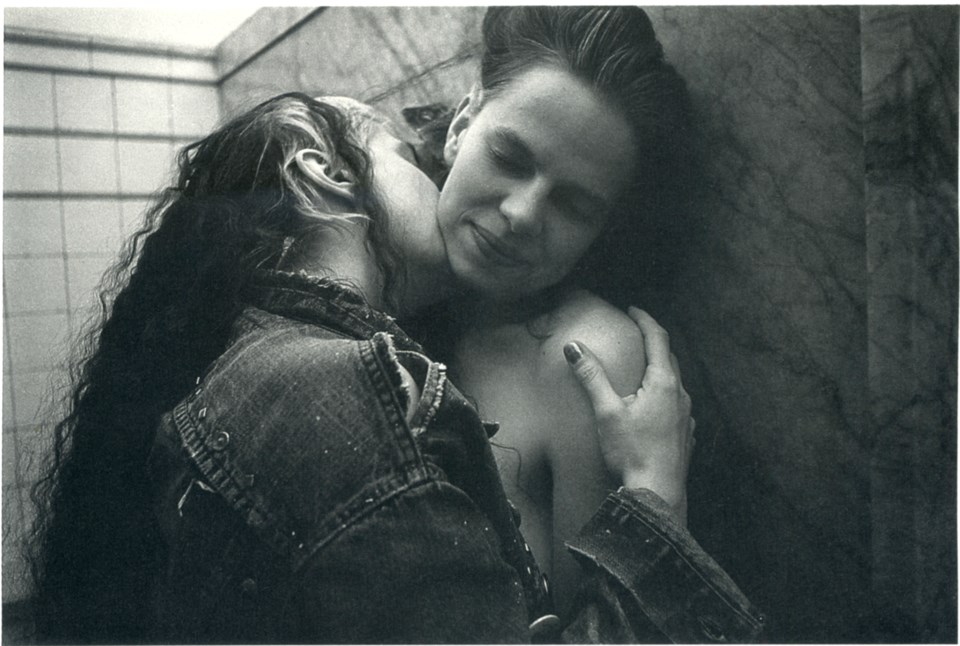More than 25 years ago, an interactive art exhibit of images depicting lesbian sexuality and sex practice, asked visitors to “Draw The Line”. Allowing outsiders to pick up a pen and write directly on the wall, thereby contributing to the piece, it ultimately let art-goers dictate what they deemed offensive, or unsettling. Over 30 photographs were put on display at Vancouver’s Women In Focus Gallery. The work of the Kiss & Tell Collective – Lizard Jones, Persimmon Blackbridge and Susan Stewart – whose presence as writers, photographers, artists and women in the LGBT community, found meaning in the cross hairs of politics and art.
At the time, Jones remembers an ever-present discussion regarding pornography and sexual representation happening in both the art and queer communities.
“A lot of people hadn’t seen porn and the conversations were intense,” she explains, “but there were also women saying the porn that did exist was not representative of ourselves, and the people we knew.”
Long before Fifty Shades of Grey made bondage, S&M, and power play appealling to the masses, Kiss & Tell’s aim was to give a voice to women, while promoting ideas of consent and empowerment in a sexual space. Thirty years ago, pornography was considered a man’s world, and women were often represented in an oppressive way.
Jones elaborates, “We said, if we make these images ourselves and say no one was hurt and the women involved had complete control, what do you think of them now?”
Audiences weren’t quite ready for the piece, Jones says thinking back to the years the collective spent touring the exhibit worldwide. However, from great conflict can sometimes, come great progress, and Jones believes the work propelled the feminist and lesbian movement forward.
“These images were difficult to look at for some, but art has always been about challenging people and sexual images have always been created by the art world,” she says. “The purpose of art is to look differently at the world around you, and you can’t do that without opening up and exploring.”
Jones has always thought of Drawing The Line as a living being, as evidenced by its interactive nature, “we did our thing, we listened,” she says. “And, it was up to others to further the concept.”
Trigger: Drawing The Line in 2015 at this year’s Queer Arts Festival asks “where do you draw the line in 2015?” Celebrating the collective’s work, QAF challenges the notion of trigger warnings surrounding art - alerting viewers to potentially traumatizing material - and questions what is being sacrificed for safety’s sake.
Jones stresses these images are a contextual piece, that it’s important for people to understand it would be impossible to remount the original show.
“It was really a different time, we were different, and gender is so different now,” she adds, “I was so naive then.”
Images are easier than ever to make today, and masses of porn are easily accessible on the internet with a few clicks of a button. The pornification of popular culture has resulted in a substantial shift in society’s mindset, and there are things we are more willing to turn our eyes to now; things that three decades ago were considered wildly inappropriate by many.
As QAF prepares to revisit the work, the philosophy of Kiss & Tell – to provoke, interest and garner discussion – remains the same.
“We never said you couldn’t hate the images, you just can’t say they shouldn’t exist.”
* Drawing The Line in 2015: What Sets You Off? Photo exhibition will be on display at the Roundhouse Community Centre July 23-Aug. 7. The artists will be onsite for a video installation and moderated talkback with Janine Fuller on July 25 at 7:30pm.


